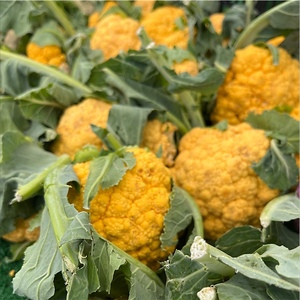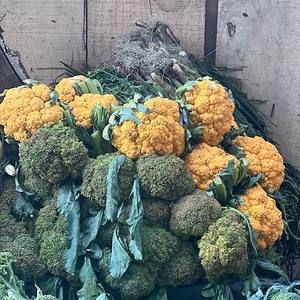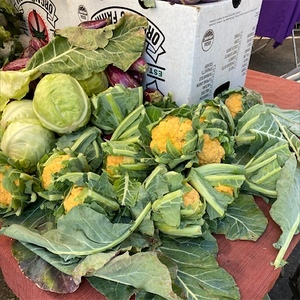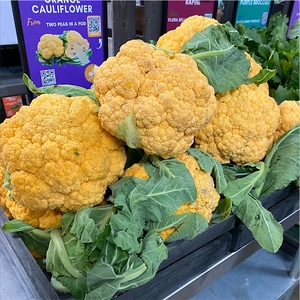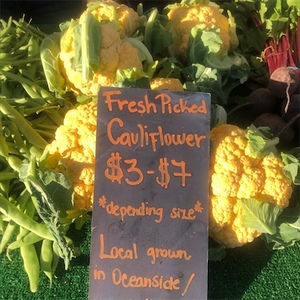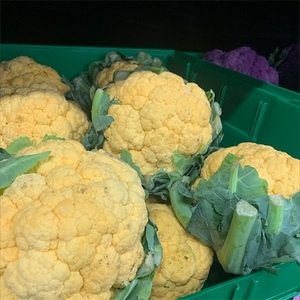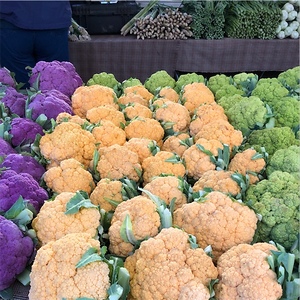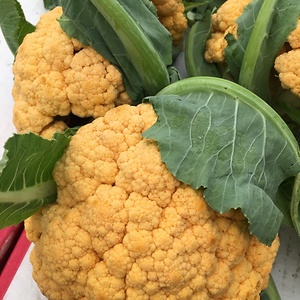


Baby Orange Cauliflower
Estimated Inventory, 24 ct : 0
Description/Taste
Baby Orange cauliflower is a cruciferous vegetable that achieves its small size through early harvesting. It resembles a mini tree, with tightly bound clusters of florets that make up small heads sprouting from stems connected to a single trunk. These heads are about 5 to 10 centimeters across and sport a bright orange-yellow color, surrounded by leafy greens that hang over them like little lettuce leaves. The head feels slightly rough due to its cloud-like shape and the dense packing of its florets, though it takes on a more crumbly texture when cut or cooked. The stem and core are a lighter, more faded orange and feel firm yet smooth. Orange cauliflower has a mild, slightly sweet smell with earthy undertones, similar to white cauliflower. Its taste is mild with nutty, sweet notes that become more pronounced when roasted, offering a sweeter and creamier taste than its white counterpart. Every part of the Baby Orange cauliflower, including the leaves, trunk, stems, and florets, is edible.
Seasons/Availability
In cooler climates, Baby Orange cauliflower can be harvested in late spring to early summer or late fall, depending on whether it is planted in early spring or late summer, respectively. In warmer climates, it can grown year round.
Current Facts
The botanical name for Baby Orange cauliflower is Brassica oleracea var. botrytis and it's part of the Brassica genus. This classification covers all sizes and colors of cauliflower, including white, purple, and green varieties. Orange cauliflower is sometimes called Cheddar cauliflower because of its cheese-like color, not its flavor. To achieve its small size, Baby cauliflower is harvested within 60 to 70 days of planting, compared to the 75 to 85 days required for traditionally sized cauliflower. As a cruciferous vegetable, cauliflower is very healthy, though different ways of cooking can change how nutritious it is. Steaming retains the most nutrients while boiling reduces them significantly. Microwaving, stir-frying, and sautéing are decent options, though eating it raw is best for maximizing its health benefits.
Nutritional Value
Baby Orange cauliflower gets its vibrant orange color from beta-carotene, which is a source of vitamin A. It contains 25% more Vitamin A than white cauliflower, making it especially good for maintaining healthy skin and vision, boosting immune function, supporting bone health, and reducing inflammation. It’s also rich in Vitamin C, potassium, and folate, nutrients that help repair and grow body tissues, reduce cardiovascular risks, and aid in regulating mood. Baby Orange cauliflower is high in fiber, a nutrient linked to weight loss, lower blood pressure, and reduced risk for obesity and diabetes.
Applications
Baby Orange cauliflower can be eaten raw, steamed, roasted, sautéed, or baked. Its small florets make it easy to use the entire head in recipes. Baby Orange cauliflower can be served raw on a vegetable tray or tossed into salads. You can add it to omelets, stir-fries, soups, casseroles, curries, and pastas. It can be baked into a cauliflower crust for pizza, diced up into cauliflower rice, mashed up like potatoes, or simply roasted with olive oil, salt, pepper, and herbs. Baby Orange cauliflower goes well with rice, couscous, Parmesan cheese, almonds, pine nuts, walnuts, sweet potatoes, carrots, and green beans. It pairs nicely with citrus, chicken, beef, pork, salmon, and shrimp, and is enhanced by herbs like turmeric, cumin, garlic, and thyme. When picking Baby Orange cauliflower, look for heads with a uniform color and tightly packed florets, free from brown spots and blemishes. They should be heavy for their size with fresh, vibrant leaves as wilted leaves are a sign of age. To keep Baby Orange cauliflower fresh, store it in a plastic bag in the refrigerator for up to a week.
Ethnic/Cultural Info
Orange cauliflower first appeared in Canada in the early 1970s, stemming from a genetic mutation that increased its beta-carotene content and turned it orange. It was then sent to Cornell University in upstate New York, where agricultural scientists bred it with white varieties to enhance its color. Over time, they developed cauliflower with a richer orange hue and higher nutritional value, particularly more vitamin A. Miniature versions of cauliflower rose to popularity in the late 20th century as part of a trend toward smaller, bite-sized vegetables. This movement catered to consumer preferences for veggies that are not only convenient and visually exciting but also perfectly sized for single servings.
Geography/History
Like all cauliflower types, Baby Orange cauliflower isn't native to any particular region but was developed through selective breeding. The original cauliflower species originates from the wild cabbage found in the northeastern Mediterranean. Cauliflower thrives in cool temperatures between 60°F and 70°F and requires a good amount of sunlight. It is primarily grown in controlled agricultural settings like home gardens and commercial farms, not in the wild. Over centuries, cauliflower has been bred across Europe and the Mediterranean before spreading globally. Michael Dickson, a vegetable breeder from Cornell University, played a key role in developing Orange cauliflower, which has since spread across North America, Europe, the United Kingdom, and Australia. While not widely known internationally, Baby orange cauliflower can be found at farmers' markets and some grocery stores, particularly during its peak season.
Recipe Ideas
Recipes that include Baby Orange Cauliflower. One
Podcasts



